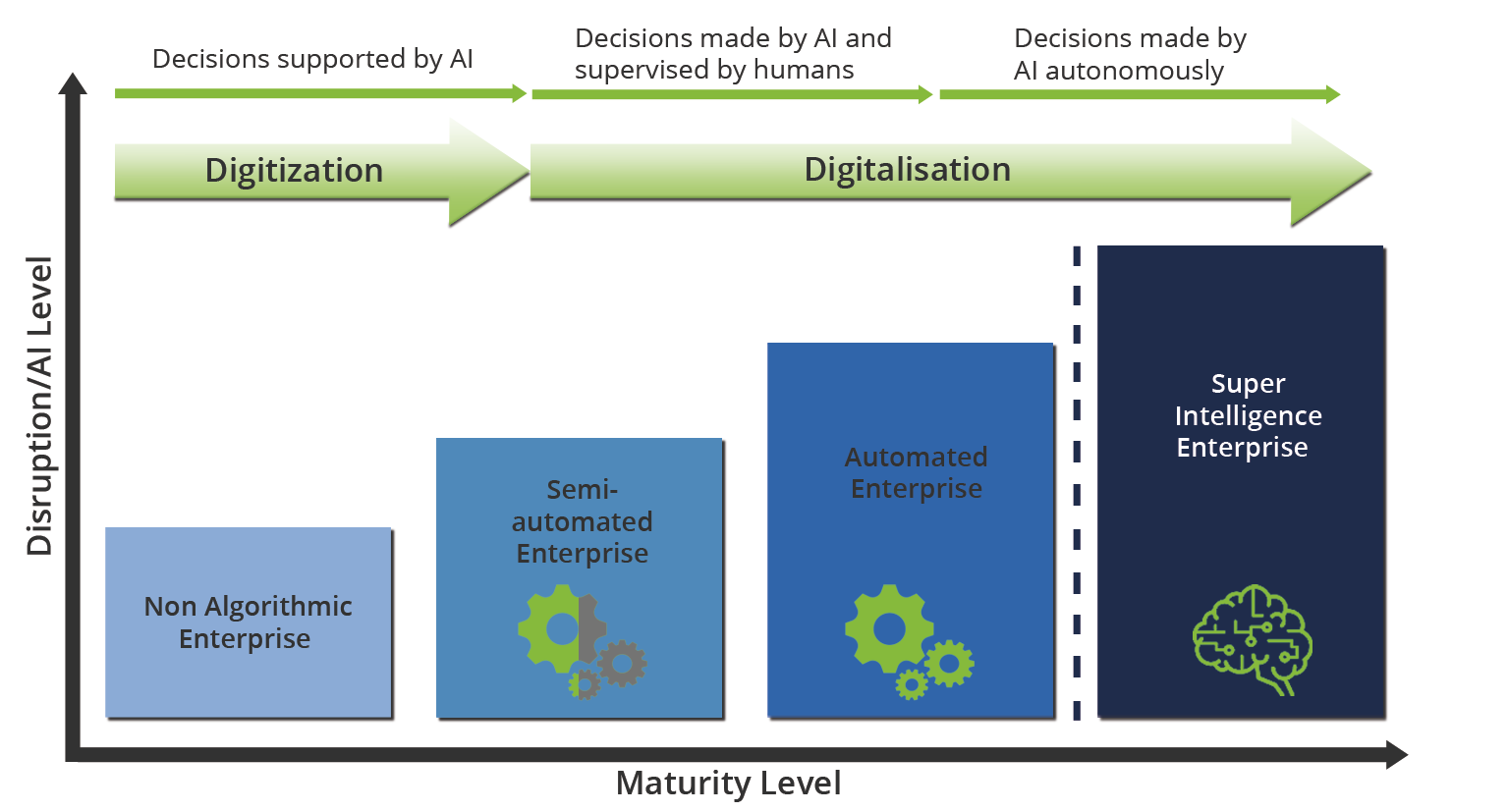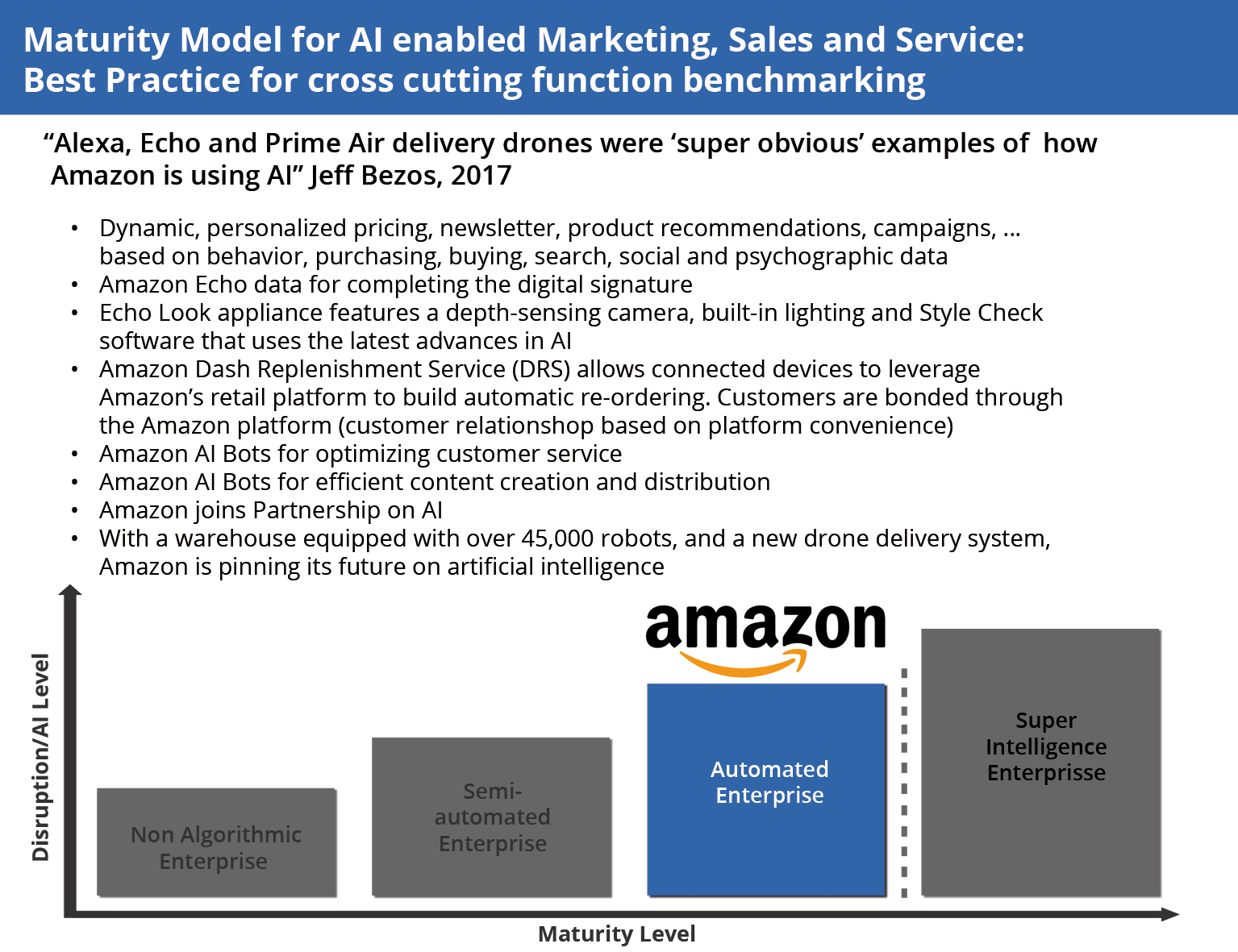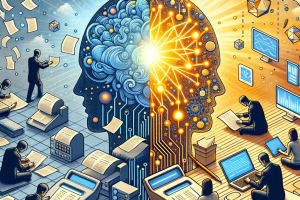FROM PROF. DR. PETER GENTSCH
Maturity levels and phases
The figure shows the different phases on the way to AI Enterprise. The model shows the different development stages from Non-Algorithmic Enterprise to Semi-Automated and Automated Enterprise. The highest maturity level is the Super Intelligence Enterprise. Here, autonomous and self-learning AI systems are used. This highest level of maturity is difficult to predict due to the uncertainty about the time of occurrence of the singularity and is not relevant in the short to medium term.
According to various expert assessments, this highest degree of maturity of AI is expected between 2040 and 2090. The individual maturity levels are described in more detail below. In the case of the Non-Algorithmic Enterprise, data, algorithms and AI do not play a business-critical role. Rather, the topics are given more operational and transactional importance. Strategy and organization are rather classical and not very analytical and data-driven. During the transition to a semi-automated enterprise, the critical value of algorithms and AI is increasingly recognized. Accordingly, there are corresponding data and analytics infrastructures. Characteristic is the increased degree of automation of data collection and analysis as well as decision making and implementation.

Fig.: AI maturity model
The consistent further development to an Automated Enterprise is achieved by the increasing automation of data acquisition and analysis as well as decision making and implementation. This is made possible by a holistic integration of data sources, analyses and process chains. At this stage of maturity, data, analytics and AI enable the design and implementation of new business processes and models. In this way, the data and analytics-driven real-time company systematically achieves competitive advantages.
While the Automated Enterprise uses narrow-AI approaches, the Super Intelligence Enterprise completes the autonomy and self-learning potential of companies through general and super intelligence. This scenario, which does not seem very realistic at present, has two forms. In the positive variant, we as humans control the framework conditions and rules of the autonomous AI systems. We always have the possibility to intervene and correct via regulative and corrective measures. Productivity and prosperity are further increased by the performance, scalability and innovations of this super-intelligence. In the negative variant, we as humans have lost control over the framework and rules of autonomous AI systems. The last call of the human being no longer exists. AI systems continue to develop in an uncontrolled manner without human intervention and without any possibility for permanent results. Even if the super-intelligence enterprise scenario still seems a long way off, there are already companies with an extremely high degree of automation.
For example, in the Henn-na Hotel (http://www.h-n-h.jp/en) in Japan, guests are welcomed by a multilingual robot that helps guests with check-in and check-out. Artificial servants bring the suitcases into the room, and there is a room for storing luggage, which is stowed away by a mechanical arm. The equipment is not a gimmick for the company, but a serious effort to increase efficiency. The hotel dispenses with keys and uses face recognition technology instead of normal electronic keys. This involves registering the digital image of the guest at check-in. In the rooms themselves, a computer ball with a stylized face takes care of the guests’ well-being. Based on digital butler technology, the computer ball can be used to switch the lights on and off, ask about the weather or a suitable restaurant. As an example of companies with a high Maturity Model the company Amazon can be mentioned. There is a high level of AI maturity across all dimensions.

Fig.: AI maturity model using Amazon as an example
A highly automated and virtual organizational construct is DAO (Decentralized Autonomous Organization). It is a virtual company without a registered office, CEO and employees, which organizes itself with the help of codes DAO breaks all crowdfunding records and collected 160 million US$ already in 2016. DAO functions like an investment fund. The collected capital is invested in start-ups and products to generate a return for the members of the organisation. The so-called crowdfunders vote in polls to decide in which direction the organisation should develop.
So-called “Smart Contracts” regulate the investments of DAO members. These are algorithms cast in software that automatically and permanently check the conditions of a contract and carry out appropriate measures. These rules are stored in a decentrally managed database – the so-called block chain. If the defined goal is reached, the Smart Contract automatically executes the transfer. According to the money paid in, the DAO members receive so-called tokens for the election, which are then used for voting. Members can also submit their own proposals for projects and ideas to be financed by the DAO. DAO automates business processes on the basis of block chain technologies. The governance rules are executed by the “Algorithmic CEO” and not by the Board of Directors as is usually the case. The result is a company organization that is completely digitalized. If one follows the definition of contract theory, according to which a company is nothing more than a network of contracts in which goals, powers and time periods are defined, the high degree of automation of company processes and decisions seems realistic.
Thus, employment contracts regulate and control the actions of employees. Employees “execute” tasks specified in contracts. The title CEO – Chief Executive Officer – is also derived from this execution rationale. Accordingly, contracts regulate everything in the company, why not executed by algorithms instead of people? Benefits and purpose The concept of a maturity model does not simply aim to classify companies into individual stages, but also provides a path that companies must follow in order to compete. Before companies deal with AI, they should systematically digitalize and structure their processes.
The benefit and purpose of a maturity model can basically be divided into three forms: Descriptive is a maturity model in the sense that a descriptive classification takes place. This provides a better understanding of the current situation. This enables companies to recognize the current status of a topic area, for example. Furthermore, a maturity model offers the possibility of a normative property. The knowledge of the current point of view is gained by the building up maturity levels of the model. The maturity model is groundbreaking when it indicates what is necessary to achieve future or higher levels of maturity. Another benefit of a maturity model is that it can be used comparatively. The position or maturity level within a model is comparable. This makes internal and external analysis feasible. On the one hand, it makes it possible to compare the company’s own departments. On the other hand, it is possible to measure the company against its competitors.
All in all, companies can locate their current status with regard to Big Data, algorithms and AI. This location determination is an important starting point on the systematic path to algorithmic business. On the basis of this location, targeted measures for the next higher level of maturity can be derived. Furthermore, benchmarking helps in and across industries.



